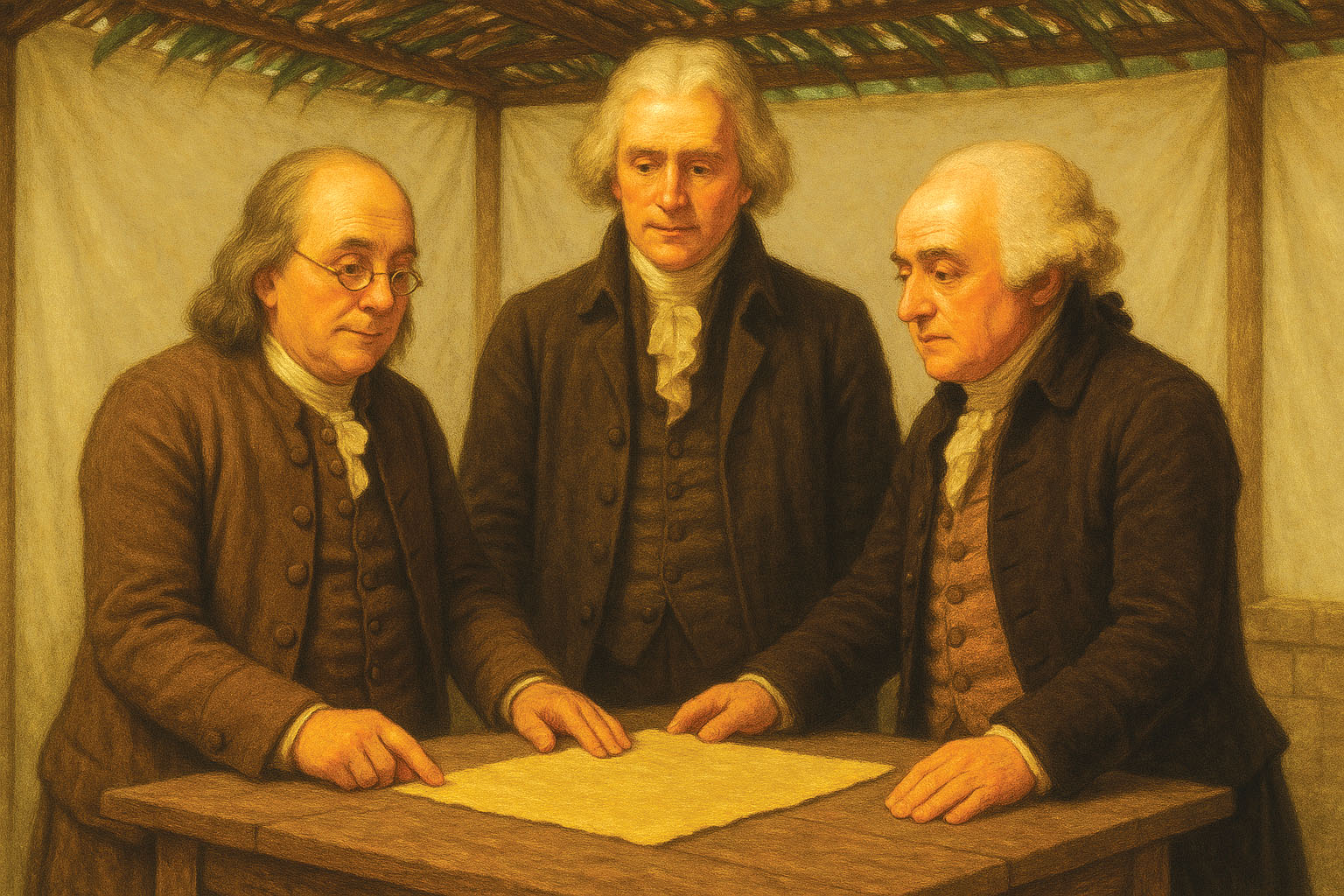A sukkah was nearly selected as the symbol of America.
On July 4, 1776, the day the Declaration of Independence was adopted, the Second Continental Congress appointed a committee to design a seal for the United States. John Adams, Benjamin Franklin and Thomas Jefferson were chosen for the task.
Franklin, amidst the early brainstorming sessions, suggested “Moses standing on the Shore, and extending his Hand over the Sea, thereby causing the same to overwhelm Pharoah who is sitting in an open Chariot, a Crown on his Head and a Sword in his hand. Rays from a Pillar of Fire in the Clouds reaching to Moses, to express that he acts by Command of the Deity.” Underneath, Franklin recommended, should sit the motto: “Rebellion to tyrants is obedience to God.”
Jefferson was a supporter of the suggested symbol, and offered a slight modification – “Pharaoh sitting in an open Chariot, a Crown on his head and a Sword in his hand, passing through the divided Waters of the Red Sea in Pursuit of the Israelites: Rays from a Pillar of Fire in the Cloud, expressive of the divine Presence and Command, beaming on Moses who stands on the shore and extending his hand over the Sea causes it to overwhelm Pharaoh. Motto: Rebellion to Tyrants is Obedience to God.”
The committee’s esteemed members were familiar with the Bible and even some rabbinic writings. As Adams would put it later in an 1813 letter to Jefferson, “The Psalms of David, in Sublimity beauty, pathos and Originality, or in one Word, in poetry, are Superiour to all the Odes Hymns and Songs in any language … To examine the Mishna Gemara Kabbala … and Talmud of the Hebrews would require the life of Methuselah,” a figure mentioned in Genesis as having lived a whopping 969 years.
Adams, in another letter, admiringly remarked “I will insist that the Hebrews have done more to civilize men than any other nation. If I were an atheist, and believed in blind eternal fate, I should still believe that fate had ordained the Jews to be the most essential instrument for civilizing the nations. If I were an atheist of the other sect, who believe or pretend to believe that all is ordered by chance, I should believe that chance had ordered the Jews to preserve and propagate to all mankind the doctrine of a supreme, intelligent, wise, almighty sovereign of the universe, which I believe to be the great essential principle of all morality, and consequently of all civilization.”
Yet even these scholarly Founders were likely unaware of the Talmudic debate as to the nature of the sukkah, the temporary tent God commanded the Israelites to sit in over the course of the holiday’s seven days.
The ancient rabbis argued as to whether the ritual building and dwelling in the sukkah was meant to evoke the man-made huts that the Israelites dwelled in as they wandered through the desert – frail, foldable structures subject to the elements. Or, comes the alternative suggestion, the sukkah is meant to evoke the divinely protective pillars of cloud by day and fire by night that protected the Israelite camp, that key element that no doubt would have been an aesthetic highlight of the Great Seal had Franklin and Jefferson’s suggestion been adopted.
Alas, the biblically-inspired idea did not survive what became six years of continued discussions amidst multiple subcommittees. Jefferson, though, did adapt the motto “Rebellion to Tyrants is Obedience to God,” on his own personal seal.
This long-forgotten footnote to American history is worth considering both for its historical import and its relevancy to the current moment.
As America’s Founders well understood — though many of today’s American citizens are unaware — the country was inspired by biblical Israel’s covenant with God. The United States, they hoped, would consist of a population united by common purpose. The land of the free would stand freed from the shackles of the monarchical tyrant of its time, England’s George III. It would have been particularly fitting for the sukkah — that beaming temporary dwelling reflective of God’s protection — to have been chosen after the American Revolution defeated England’s Pharaoh, the king whose title means “Great House.”
Comfort is to be found by reminding ourselves of the powerful pillars that Franklin and Jefferson so admired. Unwavering in the face of forces of destruction, they served as signs of God’s protective power and ultimate salvation, covering God’s covenantal people with the light of liberty.
While the sukkah didn’t ultimately make it as the seal 250 years ago, its dual nature offers a powerful symbol of America today. The frailties of the United States sometimes evoke that of a physical, man-made sukkah — the harshness of swirling societal and political winds threatening to tear down the very structure itself. But comfort is to be found by reminding ourselves of the powerful pillars that Franklin and Jefferson so admired. Unwavering in the face of forces of destruction, they served as signs of God’s protective power and ultimate salvation, covering God’s covenantal people with the light of liberty.
Rabbi Dr. Stuart Halpern is Senior Adviser to the Provost of Yeshiva University and Deputy Director of Y.U.’s Straus Center for Torah and Western Thought. His books include the newly released “Jewish Roots of American Liberty,” “The Promise of Liberty: A Passover Haggada,” “Esther in America,” “Gleanings: Reflections on Ruth” and “Proclaim Liberty Throughout the Land: The Hebrew Bible in the United States.”




